Green Envy |
||||||||||||||||||||||||||||||||||||||||||||||||||||||||||
 |
 |
|||||||||||||||||||||||||||||||||||||||||||||||||||||||||
Crocheted jacket in DROPS BabyMerino. The piece is worked in a square with fans, lace pattern and stripes. Sizes S - XXXL.
DROPS 196-28 |
||||||||||||||||||||||||||||||||||||||||||||||||||||||||||
|
------------------------------------------------------- EXPLANATIONS FOR THE PATTERN: ------------------------------------------------------- PATTERN: See diagrams A.1 to A.4. CROCHET INFORMATION: On each round which begins with 1 treble crochet, start with 3 chain stitches (which replace the first treble crochet) and finish with 1 slip stitch in the 3rd chain stitch at the beginning of the round. On each round which begins with 1 double treble crochet, start with 4 chain stitches (which replace the first double treble crochet) and finish with 1 slip stitch in the 4th chain stitch at the beginning of the round. On each round which begins with 1 double crochet, start with 1 chain stitch (which replaces the first double crochet) and finish with 1 slip stitch in the first chain stitch at the beginning of the round. STRIPES: When the piece measures 5, 10, 20 and 36 cm from the middle (adjust so that the next round is a round without treble crochet groups) work the next round with dark grey. Cut and fasten the dark grey strand when the round is finished. Do not cut the olive strand, this is carried forwards on the wrong side, but make sure it is not tight. ------------------------------------------------------- START THE PIECE HERE: ------------------------------------------------------- JACKET - SHORT OVERVIEW OF THE PIECE: The back piece is worked first in the round from the middle outwards, in a square, then worked back and forth over each front piece. The sleeves are worked in the round top down and sewn onto the square. BACK PIECE: The piece is worked in STRIPES – read description above. Work A.1 with hook size 4 mm and olive. REMEMBER THE CROCHET TENSION! When A.1 has been worked 1 time, repeat the last 2 rounds onwards with increases as before. Continue until the square measures 36-38-40-42-44-46 cm (i.e. 18-19-20-21-22-23 cm from the middle), adjust so that next round is a round as last round in diagram A.1 (i.e. a round with 1 double crochet in the middle of each side, so it is easier to divide for armhole). Now work the armholes as follows: Work over the first side as before (up to and including the first corner), work 48-52-55-59-62-62 chain stitches, skip the first half of the next side for sleeve, work the second half to the corner, the next side as before as far as the corner, work the first half of the last side as before, work 48-52-55-59-62-62 chain stitches, skip the last half of the last side for sleeve and work the last corner as before. On the next round continue the pattern as before; around the chain stitches for the sleeves work pattern as before (i.e. you work the same number of repeats as you skipped, including the increase in the corner). Continue in the round until the piece measures a total of 78-80-82-84-86-88 cm, adjust so that you finish with 1 round of double treble crochet groups (i.e. 39-40-41-42-43-44 cm from middle of square). Cut the strand. RIGHT FRONT PIECE: Start in the middle of the first corner. The first row is worked from the wrong side as follows: Work A.2b (i.e. 1 treble crochet + 2 chain stitches + 1 treble crochet are worked in the 4 chain stitches which replaced the first double treble crochet at the beginning of the previous round, 4 chain stitches, skip over first chain space, 1 double crochet around next chain space) – read CROCHET INFORMATION, then work pattern as before until there are 2 chain stitches left before the next corner, work A.2a over the corner (i.e. 4 chain stitches, 1 treble crochet + 2 chain stitches + 1 treble crochet are worked in the double treble crochet in the corner). Continue this pattern back and forth (i.e. repeat the 4 rows in A.2). Work until the piece measures 61-63-65-67-69-71 cm from the middle of the square; adjust so that you finish with 1 row of double treble crochet groups. Cut and fasten the strand. LEFT FRONT PIECE: Work as for right front piece. SLEEVE: Work 97-104-111-118-125-125 chain stitches with hook size 4 mm and olive and form them into a ring with 1 slip stitch in the first chain stitch. Work 4 chain stitches (= 1 double treble crochet), skip 1 chain stitch, 1 double treble crochet in each of the next 5 chain stitches, * skip 1 chain stitch, work 1 double treble crochet in each of the next 6 chain stitches *, work from *-* and finish with 1 slip stitch in the 4th chain stitch at the beginning of the round = 84-90-96-102-108-108 double treble crochets. Then work pattern in the round as follows: Work A.3 (= 6 stitches) and repeat A.4 over the remaining stitches (= 13-14-15-16-17-17 times in width). Continue this pattern. When the sleeve measures 4 cm, adjust so that the next round is round 3 in A.3, decrease as follows: Work 1 chain stitch, skip the first 4 chain stitches (= replaced the first double treble crochet on the previous round) and 2 double treble crochets on the previous round, continue the pattern as before until there are 3 chain stitches and 1 slip stitch left, skip 3 double treble crochets on the previous round and finish with 1 slip stitch in the first chain stitch (= 3 treble crochets decreased in each side = a total of 6 treble crochets decreased). The next round is worked in the same way as round 2 (so that the chain-spaces continue and are displaced). Continue rounds 1 to 4 as before. Decrease like this every 10-8-8-7-7-7 cm a total of 5-6-6-7-7-7 times = 54-54-60-60-66-66 stitches (on 1 round of double treble crochets). When the sleeve measures approx. 53 cm (adjust so that you finish with 1 round of chain stitches and double crochets) cut and fasten the strand. Work 1 more sleeve in the same way. ASSEMBLY: Sew the sleeves to the square with olive, in the outermost loop of the outermost stitch. |
||||||||||||||||||||||||||||||||||||||||||||||||||||||||||
Diagram explanations |
||||||||||||||||||||||||||||||||||||||||||||||||||||||||||
|
||||||||||||||||||||||||||||||||||||||||||||||||||||||||||

|
||||||||||||||||||||||||||||||||||||||||||||||||||||||||||
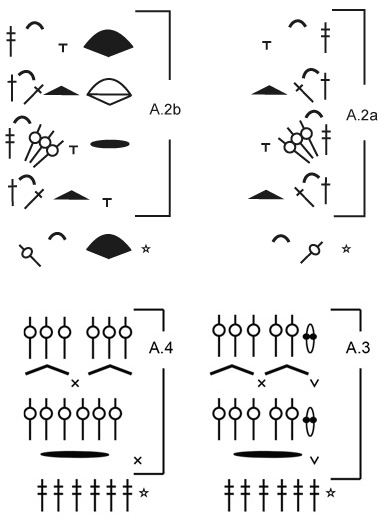
|
||||||||||||||||||||||||||||||||||||||||||||||||||||||||||
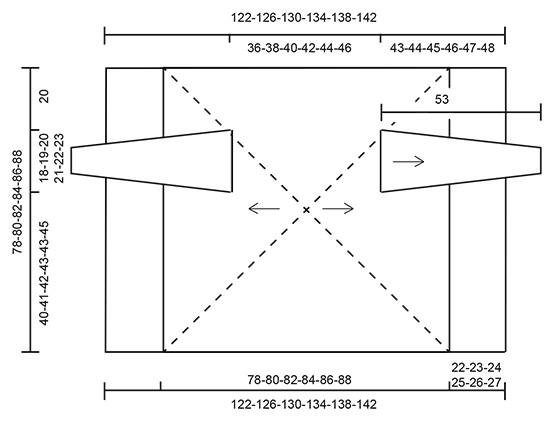
|
||||||||||||||||||||||||||||||||||||||||||||||||||||||||||
|
Have you made this or any other of our designs? Tag your pictures in social media with #dropsdesign so we can see them! Do you need help with this pattern?You'll find tutorial videos, a Comments/Questions area and more by visiting the pattern on garnstudio.com. © 1982-2024 DROPS Design A/S. We reserve all rights. This document, including all its sub-sections, has copyrights. Read more about what you can do with our patterns at the bottom of each pattern on our site. |
||||||||||||||||||||||||||||||||||||||||||||||||||||||||||







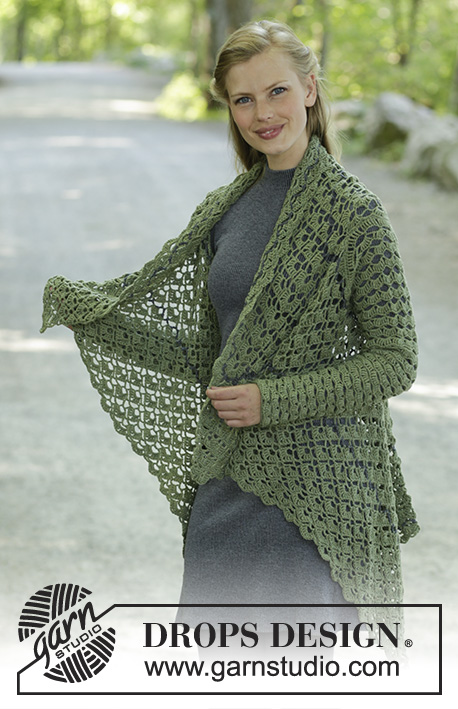




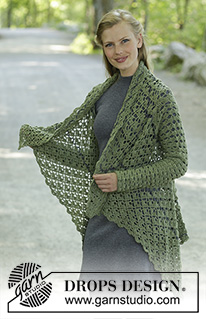

























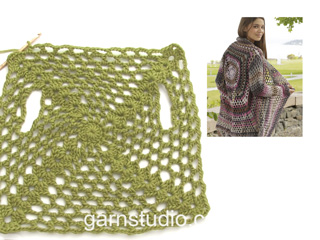


















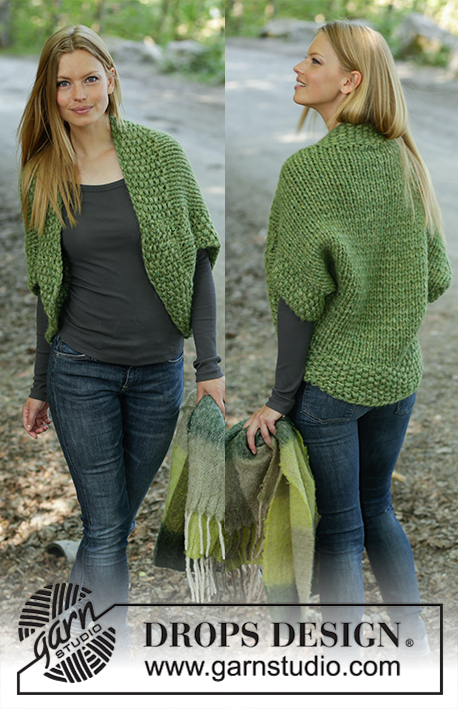








Comments / Questions (45)
Nie umiem poradzić sobie ze schematem i opisem wykonania przodu (lewego lub prawego). Jak powtarzać schemat?
28.10.2020 - 08:35DROPS Design answered:
Witaj Małgosiu! Przerabiasz 1-szy rząd na lewej stronie robótki następująco: schemat A.2b (tj. 1 słupek + 2 oczka łańcuszka + 1 słupek w 4-te oczko łańcuszka, które zastępuje pierwszy słupek podwójny na początku poprzedniego okrążenia, 4 oczka łańcuszka, ominąć pierwszy łuk, 1 oczko ścisłe wokół następnego łuku) – patrz WSKAZÓWKA, dalej przerabiasz jak wcześniej (jak na tyle), aż zostaje 2 oczka łańcuszka przed następnym rogiem, przerabiasz schemat A.2a ponad rogiem (tj. 4 oczka łańcuszka, 1 słupek + 2 oczka łańcuszka + 1 słupek w słupek podwójny w rogu). Dalej przerabiać tak samo w tę i z powrotem. Pozdrawiamy!
30.10.2020 - 09:45Bonjour Je suis en train de crocheter ce modèle et j’ai un petit soucis : quand on réalise le corps nous avons entre 2 brides 6 m en l’air et pour la réalisation des côtes on réalise seulement 2 m en l’air ? Il est mentionné que le modèle est corrigé. Donc les diagrammes A2a et A2b sont les diagrammes corrigés
14.09.2020 - 16:34DROPS Design answered:
Bonjour Zakia, quand on crochète en rond, on a effectivement 1 tour sur 2 un arceau de 6 mailles en l'air dans chaque coin, quand on continue les devants séparément, en rangs, on crochète d'un coin à l'autre avec A.2a et A.2b en début/fin de rang et comme avant entre les 2, mais on n'a plus d'arceau de 6 mailles en l'air, on crochète 1 bride, 2 mailles en l'air, 1 bride de chaque côté (rangs 1 et 3 de A.2a/A.2b). Bon crochet!
15.09.2020 - 09:26Hallo, ich habe Probleme mit den Ärmeln, ich komme mit der Häkelschrift samt Erklärung nicht klar. Bitte um Verständliche Erklärung. GlG Monika
28.08.2020 - 20:16DROPS Design answered:
Liebe Frau Weissgram, bei der Ärmel häkeln Sie zuerst 1 Runde mit nur Doppelstäbchen ( 84 bis 108 Doppelstb je nach der Größe), dann häkeln Sie die Diagramme wie folgt: A.3 am Anfang der Runde, dann A.4 13 bis 17 Mal (je nach der Größe) wiederholen. Viel Spaß beim häkeln!
31.08.2020 - 08:52Hi, I like the pattern but I m having trouble on the 4 th row I really can t understand it at all.if someone can explain the row I would appreciate it.Thank you!
06.04.2020 - 19:16DROPS Design answered:
Dear Mrs Simon, in UK-English, work 4th round as follows: 4 ch (= 1st dtr), *2 ch, 1 dtr group around next ch-space, 1 dc around next ch-space, 6 ch, 1 dc around next ch-space, 1 dtr group around next ch-space, 2 ch, (1 tr+6ch+1tr) in the dbtr at the corner*, repeat from *-* 2 more times (first 3 sides of squares are done), and finish with 2 ch, 1 dtr group around next ch-space, 1 dc around next ch-space, 6 ch, 1 dc around next ch-space, 1 dtr group around next ch-space, 2 ch, 1 slip st in4th ch from beg of round (= 4th side of square). Happy crocheting!
09.04.2020 - 14:33Jag kan inte få varv 3 att bli rätt. Finns det någon film eller annan tydlig beskrivning att se hur man gör. Det gäller DROPS Design: Modell bm-055 Green Envy. Vänligen Erika Wickman
26.02.2020 - 11:06DROPS Design answered:
Hej Erika, när du har virkat smygmaskan i 4:e lm i början på varv 2, virkar du 9lm, 1 stolpe i samma 4:e lm från förra varvet, sedan 4 lm, 1 fm om lm-bågen (i mitten på dbl-stolpgruppen från förra varvet), 4lm osv. Lycka till :)
26.02.2020 - 12:10Why have you not used the recognized standard crochet symbols in these charts? The end result makes the chart more difficult to follow. Will not be making this lovely jacket now.
29.01.2020 - 16:59En los diagrams A2a y A2 b el grupo de puntos va alrededor de los 4 puntos de cadeneta de la vuelta anterior o va en el arco de 2 cadenetas entre los dos puntos altos de la vuelta anterior?
29.10.2019 - 14:19DROPS Design answered:
Hola Sara. Los grupos de puntos altos se trabajan en el arco de 2 puntos de cadeneta de la vuelta anterior.
30.11.2019 - 23:24Buenas tardes, he terminado ya con la parte de la espalda y estoy haciendo el frontal derecho, mi pregunta es si el tejido debe de seguir creciendo ? Porque estoy siguiendo el patrón A2a y A2b y en las esquinas va creciendo con lo que no me queda un rectángulo si no que va quedando el lateral en diagonal.
29.10.2019 - 14:19Op 6 juni stelde Mieke de volgende vraag: de 2de rij is dan dubbel stokje 2losse, het dubbelstokjesgroepje, v, 6l, v enz.... als dit de manier is, dan meerdert de rij, dit kan niet de bedoeling zijn, hoe wordt dit opgelost? Ik loop ook tegen het probleem aan dat ik op deze wijze meerder. Hoe voorkom ik dit? Met vriendelijke groeten, Nelleke
23.09.2019 - 20:51DROPS Design answered:
Dag Nelleke,
Het heeft even geduurd, maar het patroon is nu aangepast met nieuwe telpatronen; er zat inderdaad een fout in.
15.11.2019 - 15:42Hallo, ich habe auch Probleme mit den Vorderteilen, die Häkelschruft ist etwas ungenau. Wird in der Hinreihe, also der mit den Stäbchengruppe, die erste Stäbchengruppe in eine 4er luftmaschenkette gehäkelt? Im Diagramm wird das ja in die 6er Luftmaschenkette gemacht. Das irritiert mich etwas. Ist es normal das dann die ersten 2 Stäbchengruppen dichter zusammen sitzen. Bitte erkläre. Lg Dagmar
17.09.2019 - 07:31DROPS Design answered:
Liebe Dagmar, ich bin etwas unsicher mit Ihrer Frage, entschuldigung. Wenn Sie die Vorderteile häkeln (separat), beginnen Sie mit A.2A (= 1 Stb, 2 Lm, 1 Stb), dann häkeln Sie wie zuvor bis nächster Ecke und mit A.2b (1 Stb, 2 Lm, 1 Stb) , zwischen A.2a und A.2b häkeln Sie wie zuvor, Diagramme zeigen die nächste Maschen, dh entweder 4 Lm oder 1Stb-gruppe um zu wissen, wie die Reihe beginnt/endet. Hoffentlich hilft es. Viel Spaß beim häkeln!
17.09.2019 - 10:22